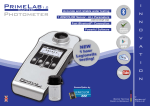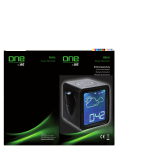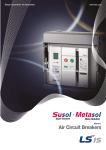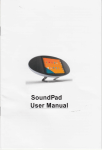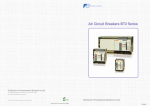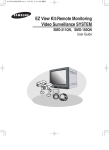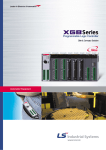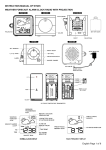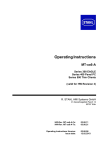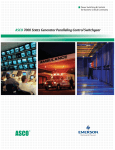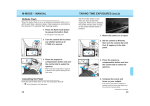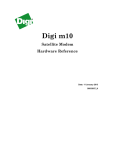Download Motor charging type
Transcript
Air Circuit Breakers It is customer's ACB that considers a customer's convenience in the use through the increase in the reliance of the operation characteristic by digital type of trip relay and the easy checking of load condition and fixed current value by LCD. LS“ATS with ACBs”interlocks the ACBs by mechanically and electrically. It is more reliable in switching operation and faster than existing ATS. The switching time is adjustable. �Application: The place which require stable power supply (Hospital, Communication facility, Computer room, Pump room, Office building) �Comparing with the existing ATS, the LS“ATS with ACBs”has high breaking capacity and protects the loads from the over-current and ground fault 2 Characteristics Environmental Policy and RoHSCompliance Features & internal structure Ratings Charging methods Auxiliary devices Electronic trip relay Operating characteristics of trip relay Characteristics curve Optional accessories ATS with ACBs Control circuit External dimensions Technical information Type selection Ordering sheet for Ace-MEC ACB Ordering sheet for ATS with ACBs Certification Internet information service 4 6 8 10 12 13 14 20 24 28 33 38 43 55 56 58 59 60 62 3 Characteristics Compact & Modular design �More compact overall dimensions and light weights. �LS Ace-MEC ACB have been made three types of modular design creteria to facilitate their installation and integration in low voltage switch boards. High breaking capacity �LS Ace-MEC ACB provides high breaking capacity up to 100kA Under 500V breaking service capacity lcu[kA] Various certification and approval �LS Ace-MEC ACB is type-tested by IEC 60947 and GB 14048-2-94 standard �KEMA (Netherlands), CESI (Italy), KERI (Korea), ISO 9001, ISO 14001 4 Safety and Convenience High functional digital type trip relay �OCR terminals are located in front �Easy inspection by LCD - Load current value - Setting values of each trip characteristics - Fault current(Max) value - Tripping time �Self-diagnosis function - noEr : No error - Err-1 : No MTD coil - Err-2 : Program error - Err-4 : Configuration resister error - Err-8 : Watch dog error �Self-test function - It is available to check whether OCR is operated normally or not by applying external power �Pre-alarm function �Contact output of the each tripping cause and LED indication �OCR alarm contact (AL, 2a) �Modulized mechanical part and accessories �for easy maintenance and inspection Improved draw-out rail for easy draw-out �Minimized arc space � Molded frame ※ The reverse connection of power source and load part is available but please use the normal connection for the safety in maintenance and inspection ※ Neutral pole of ACB 4-pole type is the breaking structure which is opened after pre-closing. Variety of accessories Optional accessories �Interlock device - MI (Mechanical Interlock) - ATSC (ATS Controller) �Key interlock, ON-Lock (K2) �Key lock( K1) �ON/OFF button lock(B) �Door Frame(DF) �Door Interlock(DI) �UVT, UVT controller: Standard(1NO 1NC) Type Operating time Rated voltage Instantaneous under AC 110, 220, 380, 460V type 0.2sec DC 24, 48, 110, 125V over Delay type 0.5sec AC 110, 220, 380, 460V DC 24, 48, 110, 125V over AC 110, 220, 380, 460V 3sec DC - �Cell switch(4C, 8C) �Shorting “b” contact (SBC, 5b max, Shorting b contact) �Safety shutter lock (STL) �Miss insertion prevent device(MIP) �Condenser tripping device(CTD) �OCR tester(OT) Standard attachment of draw-out type �Pad lock �Position indicator (connected, test, disconnected) �Counter(5-digit) �Lifting hook �Insulating barrier �OCR alarm contact (AL, 2a) 5 Environmental Policy and RoHSCompliance What is RoHS? The RoHS is an EU Directive that specifically identifies six key materiala so that manufacturers are held responsible for Ensuring that their products contain controlled concentration of the six substances restricted by the Diretive. The six Hazardous Substances : Below 1,000ppm of Lead(Pb), Mercury(Hg), Hexaval-Ent Chromium(Cr+6), Polybrominated Biphenyis(PBB) and Polybrominated Biphenyl ETher(PBDE), and below 10 Oppm of Cadimium(Cd). ▶ RoHS : Directive on the Restriction of Hazardous Substances in the Electronic Equipment (Effective on February 13.2003) Application Products manufactured by LSIS do not directly apply to the RoHS Directive. However, small inverters imbedded in sport equipment and small breakers in large home appliances can be indirectly applied to the Directive. LSIS continues to comply with the RoHS directive in order to establish environmentally Friendly management policies and global competitiveness for our products. According to the regulation, eight o the 10 WEEE products excluding‘medical equipment ’and ‘control systems’must be RoHS compliant. 6 7 Features and internal structure 2 1 4 15 3 6 7 5 8 9 13 8 11 10 12 14 1 Arc extinguishing chamber 6 OFF button 11 Pad lock 2 Control circuit terminal 7 ON button 12 Position indicator 3 Key lock 8 ON/ OFF indicator 13 Counter 4 Electronic trip relay 9 Charging indicator 14 Extension rail 5 Charging handle 10 Aperture for the draw-out handle 15 Lifting hook hole 4 3 2 1 13 21 � 14 5 15 7 8 16 9 22 6 17 11 10 12 20 19 18 1 Control circuit terminal block 9 Charging mechanism 17 Main conductor of load part 2 Control terminal 10 Closing spring 18 Contact spring 3 Auxiliary switches 11 Draw-out mechanism 19 CT for power 4 Shunt trip device, closing coil 12 Insulated base 20 Coil for current detection 5 Electronic trip relay 13 Arc extinguishing chamber 12 21 Cradle 1 6 Front cover 14 Main movable contact 12 22 Main circuit junction 7 Closing mechanism 15 Main fixed contact 8 Tripping mechanism 16 Main conductor of line part 9 Ratings LBA-06� ���C LBA-08� ���C LBA-10� ���C LBA-13� ���C LBA-16� ���C Type (In max) (A) 630, 400 800 1000 1250 Rated operating voltage Rated current (Ue) (V) 690 690 690 690 690 Rated insulation voltage (Ui) (V) 1000 1000 1000 1000 1000 Frequency Note2) (Hz) 50/60 50/60 50/60 50/60 50/60 Number of poles (P) 3,4 3,4 3,4 3,4 3,4 OCR-II Setting current (In) Rated current of (A) OCR-III Note3) For industry In max. × 1.0-0.9-0.8-0.7-0.6-0.5-0.4(7 Steps) For industry In max. × 1.0-0.9-0.8-0.7-0.6-0.5-0.4-0.3-0.2(9 Steps) For generator protection In max. × 1.0-0.9-0.8-0.7-0.6-0.5-0.4-0.3-0.2(9 Steps) (A) neutral pole Rated breaking capacity (ICU) (Sym) Rated service breaking capacity (kA) IEC 60947-2 AC (ICS) (kA) Rated making capacity (ICm) (kA) IEC 60947-2 AC (peak) Rated short-time capacity (ICW) (kA) Operating time ( t) 1250 1600 690V 50 50 50 50 50 600V 50 50 50 50 50 500V Under 65 65 65 65 65 … % × ICU 100% 100% 100% 100% 100% 690V 105 105 105 105 105 600V 105 105 105 105 105 500V Under 143 143 143 143 143 1 sec 65 65 65 65 65 40 40 40 60 30 30 30 30 50 Maximum total breaking time 40 40 40 40 40 Closing time 80 80 80 80 80 Without maintenance 12000 12000 12000 12000 12000 With maintenance 20000 20000 20000 20000 20000 Without maintenance 3000 3000 3000 3000 3000 With maintenance 5000 5000 5000 5000 5000 Mechanical Without maintenance 10000 10000 10000 10000 10000 Electrical Without maintenance 3000 3000 3000 3000 3000 Motor charging type (with cradle) Manual charging type 66/80 67/81 67/81 67/81 67/81 63/77 64/78 64/78 64/78 64/78 Cradle only 26/30 26/30 26/30 26/30 26/30 Motor charging type 43/53 44/54 44/54 44/54 44/54 Manual charging type 40/50 41/51 41/51 41/51 41/51 Horizontal type Note5) Standard Standard Standard Standard Standard (time) (time) 1000 40 Electrical ATS with ACBs Note 4) 800 2 sec (ms) Life cycle 630 3 sec Mechanical ACB Main body Draw-out type Weight (kg) (3P/4P) Fixed type Connection type Bus-bar 1600 Vertical type Motor charging type Closing type Option Option Option Option Option Standard Standard Standard Standard Standard Manual charging type Option Option Option Option Option External Draw-out type (mm) H: 435, D: 479 W(3P/4P) 350/435 350/435 350/435 350/435 350/435 dimension Fixed type (mm) H: 410, D: 375 W(3P/4P) 345/430 345/430 345/430 345/430 345/430 Certificate & Approval Note) 1. Rated current of IEC standard 2. Trip relay is divided into 50Hz and 60Hz. Please be careful when you order it. 3. The generator protection relay is only available in OCR -III. 4. Ace-MEC ACB with interlock device can be a substitute for ATS (For order, refer to page 55) 5. For mainbody, only horizontal type is available. For cradle, vertical type is optional. In case of vertical type use of the horizontal type, the user needs to apply the vertical adapter, The vertical type is standard for 4000/500AF. 6. For 4000/5000AF, height is 455mm 7. Slim type 4000AF, height is H:460, D:509 10 KERI, CESI, KEMA Note9) New LBA-20���C LBA-25���C LBA-32���C LBA-4S��EC Note8) LBA-40���C LBA-50���C Type Rated current Note1) (In max) (A) 2000 2500 4000 4000 Rated operating voltage (Ue) (V) 690 690 690 690 690 690 Rated insulation voltage (Ui) (V) 1000 1000 1000 1000 1000 1000 Frequency Note2) (Hz) 50/60 50/60 50/60 50/60 50/60 50/60 Number of poles (P) 3,4 3,4 3,4 3,4 3,4 3,4 OCR-II Setting current (In) (A) Rated current of capacity (Sym) Note3) For industry In max. ×1.0-0.9-0.8-0.7-0.6-0.5-0.4(7 Steps) Note10) For industry In max. ×1.0-0.9-0.8-0.7-0.6-0.5-0.4-0.3-0.2(9 Steps) For generator protection In max. ×1.0-0.9-0.8-0.7-0.6-0.5-0.4-0.3-0.2(9 Steps) (A) neutral pole Rated breaking OCR-III (ICU) (kA) IEC 60947-2 breaking capacity Rated making capacity (peak) Rated short-time capacity Operating time 2500 3200 4000 2500 2500 690V 50 50 50 50 50 50 AC 600V 65 65 65 65 85 85 85 85 85 85 100 100 100% 100% 100% 100% 100% 100% 690V 105 105 105 105 105 105 600V 143 143 143 143 187 187 500V Under 187 187 187 187 220 220 1 sec 65 65 65 65 85 85 (ICS) (kA) … % ×ICU (ICm) (kA) IEC 60947-2 AC (ICW) (kA) ( t ) (ms) Mechanical ACB (time) Life cycle Electrical ATS with ACBs Note 4) (time) Mechanical Electrical 2 sec 60 60 60 60 65 65 3 sec 60 60 60 60 65 65 Maximum total breaking time 40 40 40 40 40 40 Closing Time 80 80 80 80 80 80 Without maintenance 10000 10000 10000 10000 10000 10000 With maintenance 20000 20000 20000 20000 20000 20000 Without maintenance 3000 3000 3000 3000 3000 3000 With maintenance 5000 5000 5000 5000 5000 5000 Without maintenance 10000 10000 10000 - - - Without maintenance 3000 3000 3000 - - - 95/116 96/117 98/119 123/155 244/267 244/267 92/113 93/114 95/116 120/152 240/263 240/263 35/43 35/43 36/44 59/74 125/140 125/140 Motor charging type 63/75 64/76 66/78 - 119/127 119/127 Manual charging type 60/72 61/73 63/75 - 115/123 115/123 Horizontal type Note5) Standard Standard Standard - Draw Main body Motor charging type -out (with cradle) Manual charging type Weight (kg) type Cradle only (3P/4P) Fixed type Connection type Bus-bar Vertical type Motor charging type Closing type External Manual charging type Draw-out type (mm) Note6) H: 435, D: 479 Note7) W(3P/4P) dimension Fixed type Certificate & Approval (mm) H: 410, D: 375 5000 2000 500V Under Rated service 3200(3150) W(3P/4P) Option Option Option Standard Standard Standard Standard Standard Standard offer in the fixed type Standard offer in the draw-out type Standard Standard Option Option Option Option Option Option 485/615 485/615 485/615 485/615 960/1090 960/1090 480/610 480/610 480/610 - 870/1000 870/1000 KERI, CESI, KEMA Note) 9 KEMA Note) 9 KEMA, CCC Note) 8. Slim type 4000A ① The cubicle of High capacity low voltage cubicle can get the most suitable space(Dimension is 40% smaller than existing Ace-Mec ACB 4000A) ② Current capacity of neutral line(N phase) is 100% ③ When the OCR-II is applied, only external input power is available. ④ Only vertical type of plug in type is available. 9. It is guaranteed by KEMA CB certificate. 10. OCR-II is applied to only external CT (power) in slim 4000A ACB. 11 Charging method Manual charging type The closing coil is charged by manual charging handle. For closing, first charge the spring by using the charging handle, and then press the close button (I, ON) for closing, the open button(O, OFF) for opening �When closing spring is completely charged, charge Charging Handle indicator indicate “Charge” �It is mechanically locked not to press the close button OFF button (I,ON) and open button(O,OFF) simultaneously �Contact condition of the main circuit is shown on the ON button (O,OFF), (I,ON) indicator. Motor charging type The closing spring is charged by a motor ON charging method or OFF charging method is available selectively. ON, OFF Indicator Charging Indicator - OFF charging method: When the breaker opened, the closing spring is charged automatically. It can change to ON charging method by removing b(Axb) contact like beside circuit diagram - ON charging method: The closing spring is charged ●Motor charging circuit automatically when the breaker is closed. It can change to OFF charging method by using b(Axb) contact There is a contact to indicate the charging completion(TS+,TS-). Since the contact signal of charging completion switch is connected to the external terminal, It is easy to construct a circuit(ex. Automatic closing circuit) by using that contact �Manual charging is also available �With the breaker closed(I,ON), only manual charging is possible(motor charging cannot be performed) �With the open button(O,OFF) pressed, closing cannot be performed(electrical and mechanical lock) �When OFF Lock device is in use, closing cannot be worked.(electrical and mechanical lock) �Opening should follow at least one second after Note) 1. Since charging completion contact(TS+,TS-) terminal is for contact output power should not be allowed. 2. Charging completion contact capacity is equal to that high of capacity of auxiliary contact in page 27 . completion of charging �Pumping prevent circuit is included with the closing coil(electrical lock) �Please note that pumping prevent circuit can be reset ●Motor ratings when the voltage of input signal drops Voltage Reset voltage Inrush current Steady peak value(A) current(A) Rated voltage AC Rated voltage 85% under AC/DC 110 7 3.5 385 DC Rated voltage 85% under 50/60Hz 220 7 3.5 770 125 7 3.5 437 24 30 11 264 48 30 5.5 264 DC Note) The range of operating voltage: 85~110% 12 Power consumption(W) Charging time(sec) 5 Under Auxiliary devices 5 4 3 1 Pad lock(PL) To fix a ACB into a position (Dis-connected, Test, Connected) � Standard offer in the draw-out type 2 Position Indicator To indicate the position (Dis-connected,Test, Connected) of a ACB � Standard offer in the draw-out type - Connected - Test - Disconnected 3 Closing Coil (CC) �To close the breaker by remote control �The coil only operates when the power is supplied continuously over 100ms �Power should be supplied separately from the motor charging power. �Electric pumping prevent circuit is built in it. Rated voltage(V) Steady Operational Inrush current voltage(V) peak value(A) current(A) AC/DC 110 94~121 2 1 50/60Hz 220 187~242 3 1.3 125 106~138 2.3 1 24 21~26V 30 3.5 48 41~53V 30 7 DC Closing time(sec) 0.08 under 1 2 Note) 1. Closing time is from coil excitation to contact closing 2. Steady current is the value at maximum rated voltage 3. Please be careful that the pumping prevention circuit is reset when its voltage is under 85% of the rated voltage 4. The extent of operation voltage is 85~110% of the rated voltage 4 Shunt coil(SHT) �To open the breaker by remote control �Use an auxiliary contact(INO) to prevent coil burning �When the control power is ‘OFF’ at the ACB is ‘ON’ state, the ACB remains ‘ON’ Rated voltage(V) Steady Operational Inrush current voltage(V) peak value(A) current(A) AC/DC 110 77~121 2 1 50/60Hz 220 154~242 3 1.3 125 88~138 2.3 1 24 21~26V 30 3.5 48 41~53V 30 7 DC �Pumping prevent circuit Closing time(sec) 0.04 under �Trip coil circuit Note) The extent of operation voltage is 70~110% of the rated voltage. 5 OCR Alarm contact �OCR alarm contact is fundamentally installed in only ACB with trip relay. When the ACB is tripped by the OCR operation, electrical signal flows through the OCR alarm contact for remote supervisory(INO) �Contact type Type Operational type Formation of contact OCR-II Momentary operation type (Under 15ms) 2NO OCR-III Magnetic maintenance type 2NO �Contact capacity Type �Operating condition of contact Condition of circuit breaker Cause of trip TRIP Long-time delay trip, Short-time delay trip, Instantaneous-time delay trip, Ground fault trip Trip button, Shunt trip coil(SHT), Undervoltage trip(UVT) ON OFF Condition of “a” ”contact Ratings Rated current ON Maximum contact voltage OFF OFF OFF Capacity AC DC 5A AC 380V DC 125V Maximum contact current Minimum applicable load 250V 5A 30V 5A 5A DC 5V 10mA 13 Electronic trip relay OCR-II External configuration No The name of knob Mode Setting step 1 Rated current In (0.4-0.5-0.6-0.7-0.8-0.9-1.0) × In Max 2 Continuous current Ic (0.6 - 0.7 - 0.8 - 0.85 - 0.9 - 0.95 -1.0)×In 3 4 5 6 Long-time delay tripping time Short-time delay tripping current Short-time delay tripping time Instantaneous-time delay tripping current 7 Pre-alarm current 8 Ground fault current LTD 15 - 30 - 60 -120 - 240 - 480 sec (2-3-4-6-8-10-OFF) × In Is In OCR trip operation, “STD” LED is turned ‘on’ STD 0.05 - 0.1- 0.2 - 0.3 - 0.4 - 0.5 sec (4-6-8-10-12-16-OFF) × In Ii In OCR trip operation, “INST” LED is turned ‘on’ Ip Ig (0.7-0.8-0.9-0.95-1.0-OFF) × Ic In OCR trip operation, “PAL” LED is turned ‘on’ In OCR trip operation, “GTD” LED is turned ‘on’ InpNote) (0.5-1.0-OFF) ×In Max 9 Ground fault time GTD 0.1 - 0.3 - 0.8 -1.5 - 3.0 sec Note) Inp is a function for neutral protection. It protects neutral phase in 4 pole ACB from over current. LED of the trip indicator and contact LED Contact LTD T1 - Long-time delay tripping indicator Kinds of tripping characteristics STD T2 - Short-time delay tripping indicator INST T3 Instantaneous-time delay tripping indicator GTD T4 Ground fault tripping indicator PAL T5 Pre-alarm indicator RUN - - UP and off continuously LED turn on and off - Over than 120% of the setting current(In): LED turn off Formation of output terminal Type of contact Control power Tripping type 14 OCR-II Common R+ AC/DC 110~220V R2� AL1+, AL1� Pre-alarm 2 7 4 6 8 9 3 5 When the breaker closed(I,ON),“RUN”LED turn on - Over than 105% of the setting current(In): PICK 1 (0.1-0.2-0.3-0.4-0.5-OFF) × In Max AL2+, AL2� Common T0 Long-time T1� Short-time T2� Instantaneous T3 Ground fault T4 Pre-alarm T5 Button operation method in set-up modes Top MENU DIAGNOSIS Mode FREQUENCY Mode Setting MENU Rated current setting with knob. 15 Electronic trip relay OCR-II Button operation method in set-up modes Select Ground Fault FAULT Mode 16 TEST Mode OCR-III External configuration 1 Display LCD �Display of normal condition: In use current of R, S, T, N phases �Fault display: Fault phases and kinds of fault - Long-time delay trip: L _ INV EX) FAULT : R TYPE : L _ INV - Short-time delay trip: S_ INV - Instantaneous-time delay trip: INST 1 ⇒ Long-time delay trip occurring in “R” phase - Ground fault trip: GND ⇒ LCD reset method: Press “Func” button after “Ent” 2 3 Condition display LED: “Run” 5 �The LED blinks with normal operation of OCR. 2 Over-current display LED 3 �“Pick-up” LED: In case of over default pre-alarm current flows the “Pick-up” LED warning blinks and is turned off after 4 OCR operation. �“Fault” LED: The OCR operation of generating fault turns on “Fault” LED. 4 Communication display LED: “Rx, Tx” 6 �Blinks with normal communication of OCR. 5 Reset button �Out-put contact signal reset and OCR over-current display LED. 6 Selection button 7 8 �Func: Mode selection button �Ent : Selection button of various set-up value �▲, ▼: Set-up value input button 7 RS232 Port : OCR operation check port as connecting PC 8 TEST Port It is tested by IEC standard 61000-4-3 for mobile checking function and certified class “A” of frequency range from 80MHz to 2.4GHz. : Connection button with OCR tester (OT-2000) Setting step Formation of output terminal Operating characteristics Mode Rated current In Continuous current Ic Long-time delay tripping time Short-time delay tripping current Short-time delay tripping time Instantaneous-time delay tripping current LTD Is Neutral protection Ground fault time (0.2-0.3-0.4-0.5-0.6-0.7-0.8-0.9-1.0)×In max. - Generator protection Iinst Ip Type of contact Common Control power AC/DC 100~220V DC24, DC48V 0.6-0.65-0.7-0.75-0.8-0.85-0.9-1.0-no 15-20-25-30~465-470-475-480sec(Step: 5sec) - Industry 1.5-2.0-2.5~47.0-47.5-48.0sec(Step: 0.5sec) - Generator protection Alarm (Holding type contact) (2-3-4-5-6-7-8-9-10-no)×In STD 0.05-0.06-0.07~0.48-0.49-0.5sec(Step: 0.01sec) Tripping type R+( “+” ) R2-( “-” ) AL1+, AL1� AL2+, AL2� Common T0 Time(Long, Short) T2- Instantaneous trip T3 (4-5-6-7-8-9-10-11-12-13-14-15-16-no)×In - 4000AF under (4-5-6-7-8-9-10-11-12-no)×In - 5000AF over (0.7-0.8-0.9-1.0)×Ic Mark of contact Communication Ground trip T4 Pre-alarm T5 485+, 485- Note) Only AC power can be used for input power to OCR-II Pre-alarm Ground fault current Setting step 0.2-0.3-0.4-0.5-0.6-0.7-0.8-0.9-1.0(9 Steps)×In max. - Industry Ig Ig: (0.2-0.3-0.4-0.5-0.6-0.7-0.8-0.9-1.0-no) Inp: (0.5-0.6-0.7-0.8-0.9-1.0-no) GTD 0.1-0.2-0.3~2.8-2.9-3.0sec (Step: 0.1sec) 17 Electronic trip relay OCR-III Button operation method in set-up modes Set-up procedure of various set-up value Fault information method Main formation method 18 Button operation method in set-up modes Date and time set-up Self diagnosis method OCR test method Set-up value initializing method 19 Operating characteristics of trip relay OCR-II Ratings Classification Type Types and ratings of trip relays 60Hz LS6 LF6 LN6 Note1) 50Hz LS5 LF5 LN5 Note1) For industry For industry For industry 3, 4P 3,4P 3P AC/DC 110V~220V AC/DC 110V~220V AC/DC 110V~220V Application Possible number of ACB poles Operating voltage Communication Operating characteristics - - - Long-time delay (L) � � � Short-time delay (S) � � � Instantaneous time delay ( I ) � � � - � � � � � Ground fault (G) Pre-alarm (P) Setting current (A) In = … × In Max 0.4-0.5-0.6-0.7-0.8-0.9-1.0 Continuous current (A) Ic = … × In 0.6-0.7-0.8-0.85-0.9-0.95-1.0 Long-time delay(L) Trip current (A) IL = … × Ic (Error tolerance : ±10%) Trip time (sec) LTD Short-time delay(S) Trip current (A) Is = … × In (Error tolerance : ±15%) Trip time (sec) STD Instantaneous time delay(I) Trip current (A) li = … × In (Error tolerance : ± 20%) INST Ground fault(G) (Error tolerance : ±20%) Trip time (sec) Trip current (A) 1.5 15-30-60-120-240-480 2-3-4-6-8-10-OFF 0.05-0.1-0.2-0.3-0.4-0.5 4-6-8-10-12-16-OFF 0.025 under Note2) Ig = … × In Max 0.1-0.2-0.3-0.4-0.5-OFF Inp= … × In Max 0.5-1.0-OFF Trip time (sec) GTD Pre-alarm(P) Trip current (A) Ip = … × Ic (Error tolerance : ±10%) Trip time (sec) PAL = … × LTD 0.1-0.3-0.5-0.7-1.0-1.5-3.0 0.7-0.8-0.9-0.95-1.0-OFF 0.5(setting Ip 1.0), Operating time : Half of the long time inverse time Note) 1. For type LN5 and LN6, please use Neutral CT (output: 5A) in case of using 3P ACB in 3phase 4wire circuit. 2. In case of short circuit accident, instantaneous operation time of OCR is under 15ms. 3. Inp is a function for neutral protection. It protects neutral phase in 4 pole ACB from over current. �Power consumption of trip relay Operational Voltage AC/DC 110~220V 20 Ⅱ OCR-Ⅱ 5VA Note3) OCR-III Ratings Classification Type Types and ratings of trip relays 60Hz N�6 C�6 P�6 50Hz N�5 C�5 P�5 M�5 For industry For industry For generator protection For generator protection 3, 4P 3, 4P 3, 4P 3, 4P Application Possible number Of ACB poles AC/DC 110V~220V AC/DC 110V~220V AC/DC 110V~220V AC/DC 110V~220V 1 Operating voltage 2 DC24V DC24V DC24V DC24V 4 DC48V DC48V DC48V DC48V - � - � Communication protocol - RS 485 - RS 485 Protocol - DNP 3.0 - DNP 3.0 Transmission speed - 9600 bps - 9600 bps Long-time delay(L) � � � � Short-time delay(S) � � � � Instantaneous time delay (I) � � � � Ground fault (G) � � � � Pre-alarm (P) � � � � Communication Operating characteristics Rated current (A) In = … × In Max. Continuous current (A) Ic = … × In Long-time delay(L) Short-time delay(S) Trip current (A) Is = … × In (Error tolerance: ±15%) Trip time (sec) STD Ground fault(G) 0.6-0.65-0.7-0.75-0.8-0.85-0.9-0.95-1.0 �For generator protection: 1.5-2.0-2.5-3.0~46.5-47.0-47.5-48.0(Steps: 0.5sec) 1.5-2-3-4-5-6-7-8-9-10-no(Steps: 0.5) 0.05-0.06~0.49-0.5(Steps: 0.01sec) Trip current (A) li = … × In Trip time (sec) INST Trip current (A) �For generator protection: 0.2-0.3-0.4-0.5-0.6-0.7-0.8-0.9-1.0 �For industry : 15-20-25-30~465-470-475-480(Steps: 5sec) Trip time (sec) LTD Instantaneous time delay(I) �For industry: 0.2-0.3-0.4-0.5-0.6-0.7-0.8-0.9-1.0 1.5 Trip current (A) IL = … × Ic (Error tolerance : ±10%) (Error tolerance : ±15%) M�6 �4000A under: 2-3-4-5-6-7-8-9-10-11-12-13-14-15-16-no(Steps: 1) �5000A over: 2-3-4-5-6-7-8-9-10-11-12-no(Steps: 1) 0.025 under Note) Ig= … × In max �3 pole: 0.2-0.3-0.4-0.5-0.6-0.7-0.8-0.9-10-no(Steps: 0.1) Inp= … × In max �4 pole: 0.5-0.6-0.7-0.8-0.9-1.0-no (Steps: 0.1) (Error tolerance : ±20%) Trip time (sec) GTD 0.1-0.2-0.3~2.8-2.9-3.0 (Step: 0.1sec) Pre-alarm(P) Trip current (A) Ip = … × Ic 0.7-0.8-0.9-1.0 (Error tolerance : ±10%) Trip time (sec) PAL = … × LTD 0.5(setting Ip 1.0), Operating time : Half of the long time inverse time Note) In case of short circuit accident, instantaneous operation time of OCR is under 15ms. �Power consumption of trip relay Operational voltage �Trip relay type selection OCR-III AC/DC 110~220V 5VA DC 24V 5VA DC 48V 5VA N Function N C P M 1 6 Operational voltage Frequency Communication function NO 1 AC/DC 110~220V 6 60Hz (For industry) 2 DC 24V 5 50Hz Communication function YES 4 DC 48V (For industry) Communication function NO (For generator protection) Communication function YES (For generator protection) 21 Operating characteristics of trip relay OCR-II LS6, LS5 (Without ground fault trip unit) Characteristics of protection Standard functions �Setting the fixed current �Setting the long-time delay tripping current �Setting the long-time delay ripping time �Setting the short-time delay tripping current �Setting the short-time delay tripping time �Setting the instantaneous-time delay tripping current �Setting pre-alarm current ① Long-time delay pick-up current �Trip Indicator ② Long-time delay tripping time ③ Short-time delay pick-up current ④ Short-time delay tripping time: I2 t ON (Operating characteristics inverse) I2 t OFF (Operating characteristics definite) ⑤ Instantaneous pick-up current ⑥ Pre-alarm pick-up current ⑦ Pre-alarm tripping time LF6, LF5, LN6, LN5 Characteristics of protection Standard functions �Setting the fixed current �Setting the long-time delay tripping current �Setting the long-time delay tripping time �Setting the short-time delay tripping current �Setting the short-time delay tripping time �Setting the instantaneous-time delay ① Long-time delay pick-up current ② Long-time delay tripping time ③ Short-time delay pick-up current ④ Short-time delay tripping time: I2 t ON (Operating characteristics inverse) I2 t OFF (Operating characteristics definite) ⑤ Instantaneous pick-up current ⑥ Pre-alarm pick-up current ⑦ Pre-alarm tripping time ⑧ Ground fault pick-up current ⑨ Ground fault trip time 22 tripping current �Setting the ground fault tripping current �Setting the ground fault tripping time �Setting pre-alarm current �Trip Indicator OCR-III �6, P� �6, N� �5, P� �5 N� Characteristics of protection Standard functions �Setting the fixed current �Setting the long-time delay tripping current �Setting the long-time delay tripping time �Setting the short-time delay tripping current �Setting the short-time delay tripping time �Setting the instantaneous-time delay tripping current �Setting the pre-alarm current �Trip Indicator �Communication ① RS232(Port) ① Long-time delay pick-up current - Setting the fixed value ② Long-time delay tripping time - Monitoring the fixed value ③ Short-time delay pick-up current - Monitoring the operating state of ④ Short-time delay tripping time ACB OCR ⑤ Instantaneous pick-up current - Monitoring the load current of line ⑥ Pre-alarm pick-up current - Performing of calibration bility ⑦ Pre-alarm tripping time ⑧ Ground fault pick-up current ⑨ Ground fault trip time �6, M� �6, C� �5, M� �5 C� Characteristics of protection Standard functions �Setting the fixed current �Setting the long-time delay tripping current �Setting the long-time delay tripping time �Setting the short-time delay tripping current �Setting the short-time delay tripping time �Setting the instantaneous-time delay tripping time �Setting the ground fault tripping current �Setting the ground fault tripping time �Setting pre-alarm current �Trip Indicator �Communication ① Long-time delay pick-up current ① RS232(Port) ② Long-time delay tripping time - setting the fixed value ③ Short-time delay pick-up current - Monitoring the fixed value ④ Short-time delay tripping time - Monitoring the load current of line ⑤ Instantaneous pick-up current - Monitoring the operating state of ACB OCR ⑥ Pre-alarm pick-up current ⑦ Pre-alarm tripping time - Performing of Calibration ability ② RS485(Port : 485+, 485-) ⑧ Ground fault pick-up current - Setting the fixed value by remote ⑨ Ground fault trip time - Monitoring the fixed value - Monitoring the load current of line - Transmitting the failure information (failure pole, failure factor) - Transmitting the self-diagnosis information 23 Characteristics curve LS6, LS5(For industry) 24 OCR-II LF6, LF5, LN6, LN5(For industry) Ground fault (Ig) : Time(sec) 0.1-0.3-0.5-0.7-1.0-1.5-3.0 : ± 20% ±15% 25 Characteristics curve OCR-III �6, C� �6, N� �5, C� �5 (For industry) N� 26 �6, M� �6, P� �5, M� �5 (For generator protection) P� 27 Optional accessories OCR tester Ratings Name OT-2000 Rated voltage AC 100~240V Frequency 50Hz, 60Hz (selection) In max: (0-1) → If the value of In max is 1, the Output voltage voltage Stop signal Trip time Check Key to start the test. output voltage is 200mV In: (0-30)xIn max → It corresponds to the signal of the OCR (Ex. If you set In to 30, 6V turns out.) Type of output Key to initialize test current value (In, In Max) and LED(trip, testing) o, g, e Note1) Key to stop the operation of tester device (Timer, stop output signal) Key to initialize timer. (0 ms) OCR, a-contact, b-contact TC: Detect only the operation state of OCR regardless of the time delay characteristics. (Apply DC power) Key operating explanation Key that should be operated at first to revise test the current value, and select type of the test current. Key to shift the digit number of 7-segment,which shows the test current value to right direction Key to shift the digit number of 7-segment, which shows test current value to the left direction Key to select frequency (50Hz, 60Hz) Key to increase 1digit by 1digit of 7-segment that shows the test current value. Key to select type of stop signal input voltage of the OCR tester (OCR, a-contact, b-contact) Key to decrease 1digit by 1digit of 7-segment that shows the test current value. Key to initialize the test current value when ED has been pressed one time. Key to set the test current value edited by →, ←, ↑, ↓ or CL Key to test whether OCR is operated normally or not. Key to select operational characteristics of trip relay Connection method Note) 1. - o: Pre-alarm, long-time delay, short-time delay, instantaneous-time delay trip - g: Ground fault trip - e: Display output of contact except trip relay(Use to check the tester) Ⅱ OCR-Ⅱ 28 Ⅲ OCR-Ⅲ Auxiliary contact(AX) - To remote supervisory of the ON/OFF state of the ACB Ratings Standard type Type High capacity type Resistive Inductive Resistive Inductive Remark load load load load 460V 5A 2A 5A 2.5A 250V 10A 10A 10A 10A Contact 125V 10A 10A 10A 10A capacity 250V 0.3A 0.3A 3A 1.5A 125V 0.6A 0.6A 10A 6A 30V 10A 6A 10A 10A AC DC AX 5a5b ‐ Maximum HX ‐ 5a4b contact No. AC 5a5b ‐ HC ‐ 5a5b Selection Standard offer Note) Option Standard charging type High speed reclose charging type �Contact operating The condition of ACB a-contact b-contact ON ON OFF OFF OFF ON Note) When you order the high capacity type auxiliary contact, the standard type auxiliary contact is not offered. Cell switch(C) To indicate the position (connected, test, dis-connected) of a ACB It is installed in the upper and back side of a cradle. (Common use 630~5000A) Standard contact configuration - 4C: 1 Disconnected 1 test 2 connected - 8C: 2 Disconnected 2 test 4 connected(4C×2EA) ※ Please change contact configurations if you needed Note) The number of maximum contact: 8C (if needed) ON/OFF button lock(B) Miss insertion prevent device (MIP) To protect mis-operation of the ON/OFF button When the ratings of ACB and cradle does not match, this device of ACB (common use 630~5000A) mechanically prevent the ACB from being inserted into the cradle of ACB (common use 630~5000A) 29 Optional accessories Undervoltage trip device(UVT) To trip the ACB automatically when the voltage of main power or control power source reduces below its normal value. It consists of Ratings of UVT output contact UVT coil and UVT controller. UVT is attached to the inside of main body and UVT controller left Resistance load AC 125V 5A Type Voltage DC 30V 5A Inductive load 2.5A 2.5A Remark Magnetic maintenance type side of the main(Fixed type) or cradle(Draw-out). In addition, external output contact(1a1b),which can use UVT operation as external control signal, is supplied. Dimension & Circuit diagram of UVT �UVT controller outline dimension �For control power use, please apply AC power only. UVT ratings Type Instantaneous type Time delay type Name V1 V2 V3 V4 E1 E2 E3 E4 T1 T2 T3 T4 F1 F2 F3 F4 D1 D2 D3 D4 Rated Operating UVT out put Pick-up Drop-off voltage time contact voltage voltage AC 110V AC 220V AC 380V AC 460V DC 24V DC 48V DC 110V DC 125V AC 110V AC 220V AC 380V AC 460V DC 24V DC 48V DC 110V DC 125V AC 110V AC 220V AC 380V AC 460V 0.2sec under 0.5sec over 3sec over 1c 1c Over Under 85% 70% of the of the rated rated �UVT circuit of instantaneous type and 0.5 sec time delay type voltage voltage - Note) Dot line is user wiring �How to use US+, US1) Test Function As shown in above circuit diagram, please organize push button. During the operation in normal status, UVT unit will operate in a normal way if push button will be On. And, user can check the normal operation of UVT unit. 2) Reset (Initialization Function) A Formation of Circuit diagram and an operation method is as same as instruction explained in Test Function clause. It is a function for initialize function of UVT when user draws out ACB and then put it in original position in the status of normal operation. �UVT circuit of 3 sec time delay type In case of resetting or testing UVT device, please do not maintain 'ON' status of push button for a long time, and besides do not operate often ON/OFF. It can be cause of damage. (Maintenance duration of 'ON' status : Under 1 second, ON/OFF Cycle : Under 30 Seconds) 30 Note) Dot line is user wiring Key lock(K1) Key interlock(K2) To compulsorily prevent specific breaker from charging(ON) or It consists of 3 breakers to supply power stably and it is trip(OFF) when two or more breakers are used together by interlocking possible to construct key interlock by using key lock -K1: Mechanical ON protection attached to the inside of each breaker Counter (C) �Operational condition To mechanically indicate the times of ON/OFF operation of breaker ACB1 ACB2 ABC3 ON ON OFF OFF ON ON ON OFF ON Door interlock(DI) To prevent the panel door from opening when the breaker is ON Dust Cover (DC) Dust cover let us see the front side of air circuit breaker due to transparency cover and protect from various pollutions. 31 Optional accessories Shorting b-contact (SBC) Condenser trip device (CTD) It is the contact to maintain the external control circuit normal To trip the breaker electrically within regular time when the condition by disconnection of Axb of auxiliary contact when control power source is off. It is used with Shunt Coil(SHT). the position of air circuit breaker is moved from connected If there isn’t DC power,it is possible to supply the power to ACB position to test position. by rectifying the AC power. The number of shorting b contact is the same with the number(5b) of the auxiliary contact Axb of air circuit breaker. �Ratings Ratings �B6~B10 contacts(Linkage between Axb and short “b”) ACB condition ACB position Close position Open position [Auxiliary contact (Axb) : ON] [Auxiliary contact (Axb) : OFF] Connected position OFF ON Type name Rated input voltage(V) Frequency(Hz) Rated charge voltage(V) Charging time (Shorting b contact : OFF) Tripping time Test position ON ON (Shorting b contact : ON) Range of input voltage(%) Condenser capacity Specification CTD-100 CTD-200 AC 100/110 AC 200/220 50/60 50/60 140/155 280/310 Within 5sec Within 5sec over 3min over 2min 85~110 85~110 400㎌ 160㎌ �Circuit diagram Safety shutter lock(STL) To fix safety shutter for the safety during the operation in drawout state of a breaker. �Outline dimension Door frame (DF) It is the device to look fine after the cut of a switchboard door when the breaker is installed. It helps to check the front of a breaker from the outside of a distributing board easily ※ Please refer to door frame in 41, 42, 45, 46page. Mechanical operated cell switch (MOC) <Side view> 1 2 3 4 5 6 7 8 9 10 11 12 The ACB mechanically operates, only in case of “connected” position of its main board, so as to display its ON/OFF condition by contact 10a and 10b. Both Standard and large types are available. The contact capacity is identical with the rated auxiliary contacts in page 26. <Front view> 32 <Rear view> ATS with ACBs Interlock can be composed only of an electric driven charge type circuit break and there are two kinds of bar type and wire one. And in order to incorporate electric Interlock , ATS control is required separately. Electric Interlock charge closing mode, voltage trip coil, closing coil, auxiliary contactor and charge complete contactor are elements for basic composition of ACB. ATS controller rating As an operation voltage of ATS Controller it operates a motor of circuit breaker so an operation voltage of ATS controller and an operation of circuit breaker shall be used in the same way. Model Name ATSC-110 Rated voltage ATSC-110-C ATSC-220 AC110V Usable voltage range ATSC-220-C AC220V AC 93.5(±5%)~126.5V(±5%) Frequency AC 187(±5%)~253V(±5%) 50Hz/60Hz Consumption power(wave phase) 15.4W 4-Position switch(stop,N, R, Auto) ■ ■ ■ ■ Test function ■ ■ ■ ■ Transmitter control function ■ ■ ■ ■ NRS function ■ ■ ■ ■ Time setting(T1~T6) ■ ■ ■ ■ Fault function(OCR/Circuit breaker trouble) ■ ■ ■ ■ Output contact(auto, load ) ■ ■ ■ ■ - ■ - ■ Communication function (RS-485) �T1 : At the time when EPCO UN is OFF the delayed time until Generation start-up signal is closed (t1 : 0.1, 0.5, 1, 2, 4, 8, 15, 30, 40, 50 seconds) �T2 : At the time when EPCO UN is ON the delayed time until ACB2 is tripped (OFF) (t2 : 0.1, 1, 2, 4, 8, 15, 30, 60, 120, 240 seconds) �T3 : At the time when ACB is tripped(OFF) the delayed time until ACB2 is inputted(ON) (t3 : 0.5, 1, 2, 5, 10, 15, 20, 25, 30, 40 seconds) �T4 : At the time when ACB2 is tripped(OFF) the delayed time until ACB2 is inputted(ON) (t4 : 0.5, 1, 2, 5, 10, 15, 20, 25, 30, 40 seconds) �T5 : At the time when ACB2 is tripped(OFF) the delayed time until Generation start-up signal contactor is opened (t5 : 60, 120, 180, 240, 300, 360, 420, 480, 540, 600 seconds) �Stop-mode : In a state that UN (EPCO power) or UR(The Power , Station power) is usable a mode that ACB1(EPCO Circuit breaker) and ACB2 (The Power Station circuit breaker) are tripped (OFF). �N-mode : In a state that UN (EPCO power) is usable a mode that ACB1(EPCO circuit breaker) is inputted (ON) artificially -UR (The Power Station power) is not related to ON or OFF state and if converting into N-mode during use of UR (The Power Station power) Generation start-up signal is opened. �R-mode : In a state that UN (EPCO power) is usable or not a mode that ACB2(The Power Station circuit breaker) is inputted (ON) artificially in a state that UR(The Power Station power) is usable �Auto-mode : A mode that unusable power (UN or UR) circuit breaker is tripped (OFF) or usable power circuit breaker is inputted (ON) according to unusability or usability of UN (EPCO power) or UR (The Power Station power). Note) EPCO: Electric Power Co. 33 ATS with ACBs Operational condition In case of using 2 ACBs ATS Controller �If 1(One) of 2(two) connected ACBs is ON, the other is not ON electrically and mechanically by interlock. �Operational condition ACB1 ACB2 OFF OFF ON OFF OFF ON In case of using 3 ACBs Non-ATS Controller �If 2(two) of 3(three) connected ACBs are ON simultaneously, the other is not ON electrically and mechanically by interlock. �Operational condition ACB1 ACB2 ACB3 OFF OFF OFF ON OFF OFF ON ON OFF OFF ON ON OFF OFF ON ON OFF ON Interlock method Bar type Wire type Interlock is possible regardless of the Ampere Frame sizes and the number of poles. Standard length of wires are 1.8 meters <Wire Type> 34 <Bar Type> �UN: Main power(normal power) �UR: Emergency power (standby power) �Gs: Generator start-up signal �Ls: Load shedding �ACB1: N-side breaker(normal breaker) �ACB2 : R-side breaker(stand-by breaker) ∙I position: circuit close ∙O position: circuit open : there is no effect whether the condition is ON or OFF �symbol explanation Time chart 35 ATS with ACBs A flow chart of operation STOP mode R mode N mode Normal power ON Un voltage Stop Generator Stop Stand-by power ON R-mode and Un voltage Generator start-up signal t < t6 UR recover Stop generator N/R side breaker open R side breaker open N side breaker open t > t4 t > t3 N side breaker close R side breaker close Normal power ON Stand-by power ON Reset End reset Operate 4 position switch Stop operation AUTO mode Normal power ON UN voltage loss t > t1 Operate generator t < t6 UR recover UN voltage recover t > t2 R side breaker open t > t4 N side breaker close N side breaker open t > t3 R side breaker close Generator running under power ON condition t > t5 Generator OFF Stand-by power ON UR voltage loss 36 Operate 4 position switch A flow chart of operation NRS mode Auto mode Auto mode NRS Mode (D terminal) NRS Mode (D terminal) Operate generator t < t6 UR recover t > t3 Operate generator t ≥ t6 t ≥ t6 0 R side breaker close NRS Mode (D terminal) Operate generator C terminal N side breaker open Auto mode N side breaker open C terminal 1 R side breaker open t > t4 Stand-by power ON R side breaker open N side breaker close Test mode Auto mode Test button Operate generator N side breaker open t > t3 R side breaker close 180 sec Note) If you want to stop the test under test mode, press test button again 37 38 Trip relay Terminal code description Main circuit Charge complete contact Auxiliary switch Accessory code description Undervoltage trip Electric device operating (UVT) circuit Cell switch Control circuit OCR-II Trip relay Undervoltage trip Electric device operating (UVT) circuit Auxiliary switch Accessory code description Charge complete contact Note) 1. In case of auxiliary contact is high capacity, B10+ and B10- can not be used because contact composition is 5a4b. 2. Under voltage trip coil terminal such as U+ or U- shall put output power of UVT controller. 3. Above circuit diagram shows ACB locates on "Connected" position and ACB status will be trip or motor charging completion. Terminal code description Main circuit 485- 485+ Cell switch OCR-III 39 Control circuit ATS with ACBs (LS controller circuit) Note) 1. part shows optional feature“N”and“R”distributing wires are in same condition and applied OCR-II. 2. In case of connecting the trip relay (OCR-II) Control power R+/R1-: AC110V, R+/R2-: AC220V common 3. In case of connecting the trip relay (OCR-III) Control power R+/R2-: AC/DC110V�220V common use, DC48V, DC24V (R1- contact is not provided) 4. Please compose“Self maintenance circuit”because alarm contact (AL1+/AL1-, AL2+/AL2-) is a instantaneous operating(under 15ms) type in case of using OCR-II. You may not compose“Self maintenance circuit”, provided when OCR-III is using for a trip relay. 5. Please input power to the MCB1, MCB2 of controller from the primary power. (If it is tripped OCR at the load part when power is connected, power will not be transfered automatically) 6. Please connect the control power of trip relay (OCR-II. III) at the primary power section. 7. According to this circuit drawing, ACB position is“connected”standard, and ACB status is motor charged and tripped. 40 ATS with ACBs (M/G controller circuit) Note) 1. part shows optional feature“N”and“R”distributing wires are in same condition and applied OCR-II. 2. In case of connecting the trip relay (OCR-II) Control power R+/R1-: AC110V, R+/R2-: AC220V common 3. In case of connecting the trip relay (OCR-III) Control power R+/R2-: AC/DC110V�220V common use, DC48V, DC24V (R1- contact is not provided) 4. Please compose“Self maintenance circuit”because alarm contact (AL1+/AL1-, AL2+/AL2-) is a instantaneous operating (under 15ms) type in case of using OCR-II. You may not compose“Self maintenance circuit”, provided when OCR-III is using for a trip relay. 5. Please input power to the MCB1, MCB2 of controller from the primary power. (If it is tripped OCR at the load part when power is connected, power will not be transfered automatically) 6. Please connect the control power of trip relay (OCR-II. III) at the primary power section. 7. According to this circuit drawing, ACB position is“connected”standard, and ACB status is motor charged and tripped. 41 Control circuit ATS with ACBs (Manual) Note) 1. Red part shows manual wiring. 2. Above wiring drawing is simplified, please refer to page 38. 3. CAM S/W specification : 2position 4contact (4a4b). 4. MC1, MC2 specification : AX 2b/Minimum contact capacity shall be 10A. 5. Wiring of Auto/Manual mode of "N", "R" circuit breaker is composed in same way. (When ship a ACB at factory) 42 External dimensions (Draw-out type) Horizontal terminal type (630~1600A) (Unit: mm) Note 1) Note 1) [3Pole] [4Pole] [Front view] Note 1) Note 2) [Side view] [Rear view] [Connection conductor] Note) 1. Size of mounting hole 2. Size of connection conductor of Ace-MEC ACB. Door Frame (DF): (630~1600AF/3,4Pole) [In case of using DF] External size Dimension of cutting panel [In case of not using DF] Cutting panel 43 External dimensions (Draw-out type) Horizontal terminal type (2000~3200A) (Unit: mm) 603 473 252 206 67 252 336 5 5 67 27 27 100 40 40 150 118 118 150 430 UVT Controller 430 UVT Controller 42.5 200 100 4-∅14 Note 1) 278 300 [3Pole] 17 35 42.5 4-∅14 278 Note 1) [4Pole] [Front view] 379 359 12 48 Cell S/W Note 3) 25 68 20 Note 1) 57 370 218 43 15 92 132 350 430 100 175 200 21 161 Note 2) [Side view] [Rear view] [Connection conductor] Note) 1. Size of mounting hole 2. Size of connection conductor of Ace-MEC ACB. 3. Please refer to “T”dimension in 43 page. Door frame (DF): (2000~3200A, 4000~5000A/3,4Pole) External size Note) ( ) value is for 4000~5000A/3, 4pole type. 44 Dimension of cutting panel Cutting panel (396) Note) (220) Note) [In case of not using DF] Note) [In case of using DF] Vertical terminal type (630~1600A) (Unit: mm) Note 1) Note 2) [Side view] [Rear view] [Connection conductor] Vertical terminal type (2000~3200A) Note 2) Note 1) [Side view] [Rear view] [Connection conductor] �“T” Size Rated current T 2000A, 2500A 20 3200A 25 Note) 1. Size of mounting hole 2. Size of connection conductor of Ace-MEC ACB. 45 External dimensions (Draw-out type) Slim type (4000A) (Unit: mm) Operating panel center 379 458 206 5 252 67 40 150 125 21 42.5 200 4- 14 Mounting hole 57 31 100 217 200 278 [Front view] 190 [3Pole] [Side view] Operating panel center 190 117 190 190 R S T 10 S T 30 R 15 10 10 23 100 [Plane view] 200 [Rear view] 58 125 25 25 25 25 15 [Connection conductor] 46 10 395 54 118 OFF ON 455 430 125 UVT Controller (Unit: mm) Operating panel center 588 379 252 336 5 67 278 125 395 125 21 42.5 100 57 4- 14 Mounting hole 200 31 40 150 54 ON 455 OFF 430 118 UVT Controller 217 300 [Front view] 170 [4Pole] 170 [Side view] Operating panel center 170 117 170 N 170 170 R S T 10 N 30 T 10 10 43 [Plane view] 300 100 [Rear view] 58 125 25 25 15 25 S 25 R 15 10 [Connection conductor] 47 External dimensions (Draw-out type) Vertical terminal type (4000~5000A) (Unit: mm) 67 Cell S/W 48 68 12 UVT Controller [Front view] [3Pole] [Side view] 67 175 118 UVT Controller 48 58 [Front view] [4Pole] [Connection conductor] [Rear view] �Door Frame (DF): (4000~5000AF/3,4Pole): The 2000~3200A of page42 is common use. 48 External dimensions(Fixed type) Horizontal terminal type (630~1600A) (Unit: mm) 67 141 141 118 118 67 [3Pole] [4Pole] [Front view] [Side view] [Rear view] [Connection conductor] Door Frame (DF) : (630~1600A/3, 4Pole) [In case of using DF] External size Dimension of cutting panel [In case of not using DF] Cutting panel 49 External dimensions(Fixed type) Horizontal terminal type (2000~3200A) 430 20 UVT Controller 67 67 141 141 118 118 UVT Controller 20 [3Pole] [4Pole] [Front view] [Side view] [Rear view] [Connection conductor] Door Frame (DF) : (2000~3200A, 4000~5000A/3,4Pole) [In case of using DF] External size 50 Dimension of cutting panel [In case of not using DF] Cutting panel Horizontal terminal type (4000~5000A) 20 820 25 362 447 144 102 410 20 67 3.2 218 132 22 72 141 20 350 118 UVT Controller 378 181 278 19 40 295 40 842 870 [Front view] [3Pole] 20 [Side view] 950 25 362 UVT Controller 577 67 40 25 141 25 95 25 118 410 17 4-13 3.2 378 278 972 1000 130 130 130 23 [Connection conductor] 130 130 95 130 130 130 130 23 130 95 20 130 [4Pole] 20 [Front view] [Rear view] 51 External dimensions Vertical adapter attachable type In order to use as vertical type, user can attach the optional vertical adopter in the existing horizontal connection type ACB Fixed type (630~1600A) Fixed type (2000~5000A) �Needed units of vertical adopter �Size Ampere 630~1600A 2000~3200A 4000~5000A Pole Top Lower Common Total 3pole - - 6 6 Ampere 2000, 2500 4pole - - 8 8 4000, 5000 3pole 3 3 - 6 3200 4pole 4 4 - 8 3pole 6 6 - 12 4pole 7 7 - 14 (Unit: mm) A B 52 9 47 4 Draw-out type (2000~3200A) Draw-out type (630~1600A) 88 25 57 B A 125 40 307 125 25 �Needed units of vertical adopter Ampere 630~1600A 2000~3200A 52 �Size Pole Top Lower Common Total Ampere A B 3pole - - 6 4pole - - 8 6 2000, 2500 72 29 8 3200 67 24 3pole 3 3 - 6 4pole 4 4 - 8 ATS with ACBs(630~1600A) [3Pole type] [4Pole type] [Side view] Note) Above size is the standard size of our company. If you need other size, Please contact to us. 53 External dimensions ATS with ACBs(2000~3200A) 54 [3Pole type] [4Pole type] Note) Above size is the standard size of our company. If you need other size, please contact to us. �“T” Size [Side view] Rated current T 2500A 20 3200A 25 Technical information Deratings by ambient temperature �Ambient temperature: -5℃~±40℃(Only applicable when the 24 hours average temperature is below ±35℃) �Altitude: Below 2000m �Environmental condition -Below 85% in humidity with ±40℃ maximum temperature -Within the flammable, ammonia and corrosive gas environment can not be used and stored (H2S≤0.01ppm, SO2≤0.01ppm, NH3≤a few ppm) �Safekeeping temperature: -20℃~±60℃ below ±35℃ degree of 24 hours average temperature Applicable current of breaker in temperature In case of use of over 40℃ in ambient temperature, please refer to below table as adjusting the rated currents Type Ambient temperature LBA-06 LBA-08 LBA-10 LBA-13 LBA-16 LBA-20 LBA-25 LBA-32 LBA-40 LBA-50 40℃ 630 800 1,000 1,250 1,600 2,000 2,500 3,200 4,000 5,000 45℃ 630 800 1,000 1,250 1,600 2,000 2,500 3,200 4,000 5,000 IEC60947-2 50℃ 630 800 1,000 1,250 1,600 2,000 2,500 3,200 4,000 5,000 ℃) (Standard temp: 40℃ 55℃ 630 800 1,000 1,250 1,550 2,000 2,450 3,000 3,900 4,850 60℃ 630 800 1,000 1,200 1,500 2,000 2,350 2,900 3,750 4,700 > 60°℃ and < 100°℃ 315 400 500 630 800 1000 1250 1575 2000 2500 Note) The data at 40℃ are according to IEC 60947-2 Arc Space When designing switchboard, please keep the distance more than the recommended insulation distance between Ace-MEC ACB and switchboard. (Unit: mm) Type Fixed type Draw-out type A 25 25 B 150 150 Note) The number of "A" shall be increased in proportion to the size when attaching UVT, Mechanical Interlock, Door Interlock. 55 Leader in Electrics & Automation � For your safety, please read user's manual thoroughly before operating. � Contact the nearest authorized service facility for examination, repair, or adjustment. � Please contact qualified service technician when you need maintenance. Do not disassemble or repair by yourself! Safety Instructions � Any maintenance and inspection shall be performed by the personnel having expertise concerned. www.lsis.biz � HEAD OFFICE Yonsei Jaedan Severance Bldg., 84-11, Namdaemunno 5ga, Jung-gu, Seoul, 100-753, Korea Tel. (82-2)2034-4870 Fax. (82-2)2034-4713 � Global Network �LS Industrial Systems Tokyo Office � �Tokyo, Japan Address: 16F, Higashi-Kan, Akasaka Twin Towers 17-22, 2-chome, Akasaka, Minato-ku Tokyo 107-8470, Japan Tel: 81-3-3582-9128 Fax: 81-3-3582-0065 e-mail: [email protected] �LS Industrial Systems Dubai Rep. Office � �Dubai, U.A.E Address: P.O.Box-114216, API World Tower, 303B, Sheikh Zayed road, Dubai, UAE. Tel: 971-4-3328289 Fax: 971-4-3329444 e-mail: [email protected] �LS-VINA Industrial Systems Co., Ltd � �Hanoi, Vietnam Address: LSIS VINA Congty che tao may dien Viet-Hung Dong Anh Hanoi, Vietnam Tel: 84-4-882-0222 Fax: 84-4-882-0220 e-mail: [email protected] � CHEONG-JU PLANT Cheong-Ju Plant #1, Song Jung Dong, Hung Duk Ku, Cheong Ju, 361-720, Korea �LS Industrial Systems Hanoi Office � �Hanoi, Vietnam Address: Room C21, 5Th Floor, Horison Hotel, 40 Cat Linh , Hanoi, Vietnam Tel: 84-4-736-6270/1 Fax: 84-4-736-6269 �Dalian LS Industrial Systems Co., Ltd. � �Dalian, China Address: No. 15 Liaohexi 3 Road, Economic and Technical Development zone, Dalian, China Tel: 86-411-8273-7777 Fax: 86-411-8730-7560 e-mail: [email protected] �LS Industrial Systems (Wuxi) Co., Ltd. � �Wuxi, China Address: 102-A National High&New Tech Industrial Development Area, Wuxi, Jiangsu, China Tel: 86-510-534-6666 Fax: 86-510-522-4078 e-mail: [email protected] �LS Industrial Systems International Trading (Shanghai) Co., Ltd � �Shanghai, China Address: Room E-G, 12 th Floor Huamin Empire Plaza, No.726, West Yan’an Road Shanghai 200050, P.R. China Tel: 86-21-6278-4291 Fax: 86-21-6278-4372 e-mail: [email protected] �LS Industrial Systems Shanghai Office � �Shanghai, China Address: Room 1705~1707, 17th Floor Xinda Commercial Building, No.322, Xian Xia Road Shanghai 200336, China Tel: 86-21-6208-7610 Fax: 86-21-6278-4292 �LS Industrial Systems Beijing Office � �Beijing, China Address: B-Tower 17 Fl. Beijing Global Trade Center B/D. No. 36, BeisanhUanDong-Lu, DongCheong-District, Beijing 100013, P.R. China Tel: 86-10-6462-3254 Fax: 86-10-6462-3236 e-mail: [email protected] �LS Industrial Systems Guangzhou Office � �Guangzhou, China Address: Room 1403, 14F, New Poly Tower, 2 Zhongshan Liu Road, Guangzhou, China Tel: 86-20-8326-6754 Fax: 86-20-8326-6287 e-mail: [email protected] �LS Industrial Systems Chengdu Office � �Chengdu, China Address: 12Floor, Guodong Building, No52 Jindun Road Chengdu, 610041, P.R. China Tel: 86-28-8612-9151 Fax: 86-28-8612-9236 e-mail: [email protected],com �LS Industrial Systems Qingdao Office � �Qingdao, China Specifications in this catalog are subject to change without notice due to continuous product development and improvement. 2006. 07 Address: 7B40,Haixin Guangchang Shenye Building B, No. 9, Shangdong Road Qingdao, China Tel: 86-532-580-2539 Fax: 86-532-583-3793 e-mail: [email protected] Ace-MEC ACB (E) 2003. 04 / (14) 2006. 07 Printed in Korea STAFF


























































